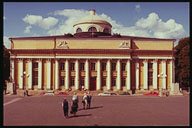 Finland
Finland
 Finland
Finland

| Directory Information | Catalogs, Bibliographies, and Indexes |
| History | Reference and Reader Services |
| Organization | Automation |
| Buildings and Facilities | Statistics (1993) |
| Collections |
Formal Name: Helsingin Yliopisto, Kirjasto
(The National Library of Finland)
Name of Librarian: Professor Esko Häkli
Address:
PL 15 (Unioninkatu 36), 00014 Helsingin Yliopisto
Phone: (09) 19122709 Fax: 19122719
E-mail: HYK-palvelu@helsinki.fi
The Helsinki University Library was established in 1640 as the library of the Academy of Turku (Åbo), the old capital of Finland. In 1707 it became a legal deposit library for the Kingdom of Sweden-Finland. By 1804 it contained 30,000 volumes. However, in 1827 the town of Turku and the library were destroyed by a disastrous fire. The university and the library were moved to the Helsinki, the new capital of Finland.
In Helsinki the library received a magnificent new building designed by Carl Ludvig Engel in 1840. From 1827 to 1917, the University Library received on legal deposit everything printed in the Russian Empire. The large reading room with its reference works was opened to the public in 1893, and the semicircular stack tower projecting into the yard and designed by G. Nyström, was opened in 1906. In 1908 the catalogues of foreign and national literature were placed at the disposal of the public. After independence in 1918, the Library received deposit copies of all printed publications in Finland.
The holdings of the library comprise at present more than 3 million books and pamphlets as well as an unestimated number of other items.
"Helsinki University Library is the national library of Finland. It bears the name of university library but is much less a typical university library than a national library.
"Within the university the library is a separate institution, having no organizational ties with faculty and departmental libraries, which carry the main responsibility for the daily library services of the academic community. The only important exception is the Undergraduate Library, which has since 1974 been a separate department of the University Library." Administratively, the library is a separate service institute subordinated to the Small Senate (Consistorium minus) of the university. Its head is the chief librarian.
"In addition to its role as a national library Helsinki University Library is officially the basic resource library (national central library) in arts and humanities for the whole country."
"The Helsinki University Library, designed by C.L.Engel, was completed in 1840. The building is one of the most beautiful neoclassical libraries in Europe. The floor plan and the vaulted peristyle halls are inspired by the world of Roman thermae. The library became a temple of knowledge, facing the main church of the town, the Nicholas Cathedral, which was built during the same period as the library." The semicircular annex Rotunda at the back of the building, designed by Gustaf Nyström in 1906, provided the Library with additional space. Helsinki University Libraary is in a process of substantial modernization. In few years time, when the adjacent building has been renovated for the Library's use, it will be able to offer new services.
As a result of the Library's unique position in the past, it houses the only notable collection of older literature in Finland as well as the only legal deposit collection prior to the 1920s in the country. "The library also collects published material written by Finns elsewhere in the world; the collection of literature written by Finns in North America, which may be the most complete of all existing collections of such material, should be specially mentioned. Literature about Finland is also purchased."
"Along with the collections of printed material the library has large and important collections of historical Finnish manuscripts, starting with fragments of the medieval literature of Finland; the library also possesses the richest collection of musical manuscripts of Finnish composers, including the manuscripts of Jean Sibelius..."
"The foreign collections from earlier times are reasonably good as a result of the many important donations the library received after the 1827 fire. Donations received from St. Petersburg (from the Imperial Court and the Imperial Academy of Sciences) were especially rich in historically important items. Helsinki University Library thus received books that had belonged to such well known Russian personalities as the founder of Russian science, Mikhail Lomonosov, or to important private libraries."
"Even more important was the legal depossit right to everything printed in the Russian Empire, which the university received after Finland was separated from Sweden and attached to Russia as an autonomous Grand Duchy susbordinated directly to the Czar. In this way a remarkable collection of Russian literature for the period 1827-1917 was created, the mosst complete collection outside the present Soviet Union. Internationally it is clearly the most interesting of the library's collections. It forms the basis of the present Slavonic Library, which is a department of Helsinki University Library."
"The same legal deposit right brought also other types of interesting material, publications printed in all the languages of the large Empire. Helsinki University Library thus possesses important collections of material printed in English, Estonian, French, Georgian, German, Hebrew and Yiddish, Lettish, Polish, Turkish and other languages. Many of these are of great historical importance."
"Well known to historians of cartography is the large private library of the exploreer Adolf Erik Nordenskjöld, which was bought in 1902. It is one of the great collections of historical maps in the whole world."
The oldest item in the manuscript collection is the collection of papyri from 300-200 BC. The Library's collection of old valuable maps enjoys a good international reputation. The oldest complete book in the Library's possession is Rabanus Maurus' De sermonum proprietate, [romted om Strasbourg in 1467.
Catalogs, Bibliographies, and Indexes
"Helsinki University Library is responsible for the entry of new material into the national bibliographic database and for the production of printed bibliographies. The national bibliography, Suomen kirjallisuus, is published monthly and as an annual cumulation."
"The deposit copies received by the library form the basis for bibliographic recording....The library records also literature published abroad by Finns as well as translations of Finnish authors. Publications on Finland are also recorded in the database, from which a separate catalogue, Fennica Extranea, is produced."
The Finnish national bibliography is also available as a CD-ROM database. The Library has also transferred a valuable collection of antique maps to an interactive videodisc..." The Library is involved in producing The Retrospective National Bibliography 1488-1827, a comprehensive bibliography of Finland's early literature up to the fire of Turku in 1827. The first phase will produce a bibliographic database covering the whole period. The database will be accessible online, and a printed bibliography will be published later.
As the main library of the University, the Library provides two-thirds of the University's total library services, including a text-book service for seven of eight faculties. There are nearly 30,000 regular students and 15,000 open university students at the university. About 140 doctoral dissertations are published annually.
The vast majority of loans, more than 400,000 in 1993, are made by the Undergraduate Library, a department of the University Library. The main Library, together with its two other departments makes more than 100,000 loans. The demand for services has been growing by 10 per cent annually.
"Services which Helsinki University Library provides as national library are closely connected with the library's activities as the National Central Library for Arts and Humanities, whhich also include the services given by the Slavonic Library."
"Because the library receives only one legal deposit copy of Finnish material, possibilities for extensive lending activities do not exist. The Finnish collection has, according to the instructions issued by the Minisstry of eDucation, to be kept as an archival collection; this means that the material can be consulted in the reading rooms, but it is not lent out, either to individuals or through interlending to other libraries."
The Library was a pioneer in the use of modern technology. Since the 1970s cataloguing of current Finnish literature has been computerized, and the traditional card catalogues have been replaced by a database. The Finnish National Bibliography is also available as a CD-ROM database. The Library has also transferred a valuable collection of antique maps to an interactive videodisc and assisted other libraries in converting their card catalogues into machine-readable form.
Local use of the library's catalogues takes place today through networks. users are able to find the material they need with the help of their own computers in the University's electronic catalogue, which is maintained by the University Library.
All academic libraries in Finland use identical computerized systems connected by the joint library network LINNEA. This most far-sighted and internationally unique decision was made about ten years ago. Today, Helsinki University Library is able to offer several union catalogues, national and international, for the use of academic and public libraries as well as for private information services.
VTLS, Inc., which runs on Hewlett-Packard hardware, is the integrated system chosen by the Finnish libraries. In addition to providing local systems for all the academic libraries in Finland, it also provides a union catalogue (LINDA) of the collections of the these libraries. It is up-to-date and easy and efficient to use.
Staff 225
Volumes 2,944,300
(Books and Periodicals)
Other material 2,452,000 sy
Visitors 630,000
Loans 541,000
Interlibrary Loans
Supplied 13,956
Received 2,919
Finance
Acquisition of literature
6,530,000FIM
Collection, maintenance,
microfilming
1,856,000FIM
Automation
1,540,000FIM
Operating costs
3,252,300FIM
Total
13,178,300FIM
All information taken from brochures and articles supplied by the
National Library of Finland.